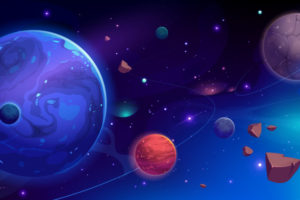Universe or Multiverse – what’s the buzz?
Apr 1, 2021

💫 What do we mean by the word “universe”?
In a global sense, the universe originally meant “everything”, that is, every galaxy, planet, person, and even our thoughts are part of this “everything”. But subsequently, scientists abandoned such a value since it does not sound entirely scientific. Now it is customary to call the universe a separate region in which space expands after the Big Bang.
The birth of our universe
Our universe appeared more than 13 billion years ago from an explosion presented by academic writers as a Big Bang. During the first seconds of its existence, the universe was too hot for any material objects to be formed. Over time, the universe began to cool down and electrons flying by collided with protons, forming atoms, which subsequently created stars. In the bowels of these first stars, due to the crazy temperature causing a thermonuclear reaction, atoms were born, which served as the building blocks for everything we know out there, even ourselves. Subsequently, in the cluster of stars, which we call the Milky Way, our Sun was born. This birth and the material that was emitted in the nearby space created all the planets in our Solar system.
The concept of a multiverse
Imagine that our universe is not everything that exists, but only a certain region of space. According to one of the currently existing hypotheses, there is an infinite number of universes spontaneously born in space. These new Big Bangs occur outside our universe. They grow and develop just like our universe, but they may have quite different laws of physics and chemistry.
To understand where these universes are located, let’s try to describe the situation in simpler words for clarity. For us, people, to receive information, we need a signal. This signal can take many forms, but the simplest and most understandable is the light signal. That is, to see something, we need the light to reach our eyes, or to our measurement devices.
But why can’t we see other universes?
To answer this question, it is worth going back to our school years. We all remember how we got acquainted with light in a physics lesson. And we all remember that one of the light’s unique features is speed. Each of us must have heard, “Nothing can travel faster than the speed of light in a vacuum.” Indeed, nothing in space can move above the speed of light, but space itself can do whatever it wants. Space is not subject to what we were taught in schools. As mentioned above, space is in the stage of constant expansion and this expansion occurs at a speed exceeding the speed of light, and in some places several times. That is why we cannot see other universes beyond ours.
To get a complete picture of the multiverse model, let us draw an analogy. We’ve all seen surfers trying to ride the wave at least once. In this analogy, our light is this surfer, and water is the space. So, let’s imagine further that the tide began, and the surfer did not have time to get ashore. He will try as much as possible to swim to land – the same thing as what light is doing trying to reach us. But what if the speed of the water is faster than the speed of our surfer? The answer is quite obvious – an unfortunate person will never be able to swim to the shore. The same happens in the universe, when space expands at a speed exceeding the speed of light, the light will never be able to reach us, as it is carried away by the current caused by the expansion of space.
🪐 The bottom line
Now everything has fallen into place. Our universe can be represented as a constantly expanding bubble located next to other bubbles. Since the space between them expands faster than light can move, the light from another universe simply cannot reach us – similar to a surfer who cannot reach the shore at high tide. This is why we cannot see with even the most sophisticated measurement devices these other bubble-universes.

Time is precious
don’t waste it!
Get instant essay
writing help!






